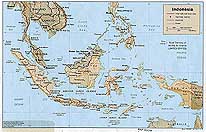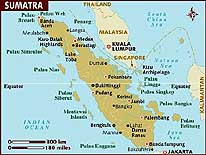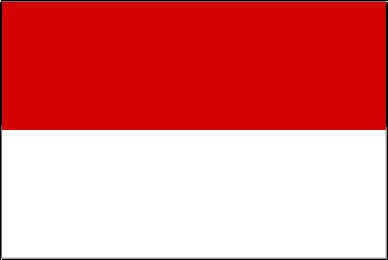-
- Indonesia
Map Sumatra Map
|
-
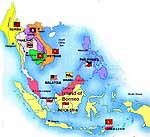
-
-
Map of Southeast Asia
-
|
-
-
|
- More websites from Indonesia and Timor-Leste:
|
-
- latest picture taken: May 23, 2010
- click a picture to see details
|
-
-
-
-

|
-
-
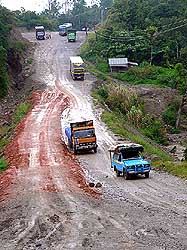
|
-
-
-
-
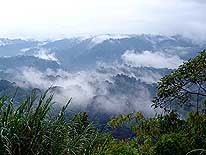
|
- 76
On the way from Tarutung to
- Padangsidempuan we cross
- this “steaming” jungle river
|
- 77
Our LandCruiser accelerates
- to tackle the steep ascent towards
- Sipirok, where stranded lorries
- wait to be winched up
|
- 78
Mist is spreading through the
- rainforest along the Sibolga bypass,
- giving it a mystical appearance
|
-
- According to the general weather chart, a huge depression is approaching Sumatra on May
1st, 2010. It is the day when we finally hit the road after 33 relaxed days at Lake Toba
in Northern Sumatra and take the ferry at 10am from Samosir
Island back to Parapat on the mainland. Unavoidably, we are heading straight into the
heavy downpour. The rain pounds ceaselessly against the windscreen, and despite of having
fixed some leaking spots only last week, we get wet feet. It seems that the rubber on both
sides of the windscreen is damaged. But we could not postpone our trip Southwards any longer, as we already booked our flights with
Air Asia to Kuala Lumpur from Padang for May 6th. And there are still 300 miles with
unknown road conditions to go. In Malaysia, we need to apply
for a new Indonesian two-months visa (it is easier than the one-monthly extensions done
within the country) and to get our teeth problems further under control: Emil his gums and
I my tooth canal treatment.
|
-
-
-
-
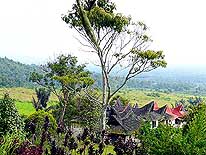
|
-
-
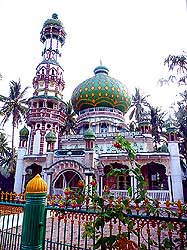
|
-
-
-
-
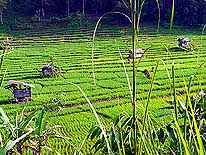
|
- 79
View from the hill of the Torsibohi
- Resort in Sipirok over the fertile valley
|
- 80
This splendid mosque stands
- in the otherwise characterless
- village of Kotanopan
|
- 81
Lush green paddy fields
- turn up at every corner
|
-
- In the village of Tarutung, we divert from the Trans Sumatra Highway to an inland
shortcut that bypasses the coastal town of Sibolga. According to Annette from Tabo
Cottages in TukTuk and a truck driver we just questioned at the gasoline station, the road
condition of this by-pass is better than on the main road. A car driver from Medan with
whom we talked about it on the ferry ride however told us just the opposite. Who is right?
What we want to avoid by all means is the infamous stretch where apparently trucks have to
be winched up one by one. Memories of Guyana and Congo (ex-Zaire) come alive! We had gone only a few
miles on the windy, narrow road with little traffic, when we meet our truck driver again
– unfortunately stuck at the scene of an accident: He just collided with an oncoming
lorry. Luckily, there seem to be no injuries, but we notice that the fronts of both trucks
are badly smashed when we squeeze past them. Apropos good road: Soon afterwards, the
pavement ends. Then a steep descent follows, it gets muddier and muddier and suddenly a
huge mud hole, not to be underestimated, lies in front of us. Due to our weight, quagmire
has always been and will always be one of our biggest nightmares. And the one here it is
no exception.
|
-
-

|
-
-
-
-
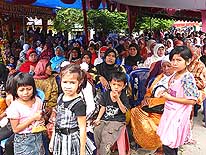
|
-
-
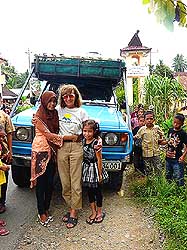
|
- Wedding of the Minangkabau people near Padangsidempuan. The Minangkabau form one of the
few still existing matrilineal
- societies on earth. i.e. where property and land is passing down the female line from
mother to daughter
|
- 82
The bridal couple is sitting on the
- throne adorned in gold and red .....
|
- 83
..... the wedding guests –
- strongly devoted to Islam – listen
- to the words of the Imam …..
|
- 84
..... a student and a little girl
- spontaneously embrace Liliana in
- front of the car before saying good-bye
|
-
- We engage our 4x4, take a big breath and ..... yes, we make it! We are happy but not yet
relaxed. Immediately after, a pretty steep ascent is ahead of us, where trucks are
stranded waiting to be winched up one by one. Isn’t it exactly this passage we wanted
to avoid by all means? Well, now there is only one way to go anyway: Forward! But
amazingly, it is a piece of cake for our old LandCruiser. Before we really realize it, we
are already “over the mountain”! In the mean time dusk is sitting in, and
camping alongside the road is out of question – there is no possibility to pull out
anyway. Therefore, we want to reach Sipirok – apparently the only place with an
accommodation along this route. It is already night when the gate to the “Torsibohi
Resort” opens and we drive up the hill to the parking lot. The big disappointment
comes at the reception: All rooms are booked out. Actually, we should have known it.
Sitting at an altitude of 300ft, this region attracts crowds of lowland people at weekends
who want to escape the scorching heat. And today is a Saturday! The only accommodation
available is a villa with two bedrooms, three bathrooms, a living room and a kitchen for
four people, to a promotion rate of 1,12 Mio Rp. (= US$125), including a welcome drink,
dinner and breakfast for four people! Our heads are spinning.
|
-
-
-
-
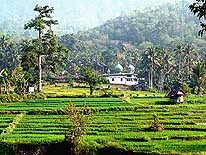
|
-
-
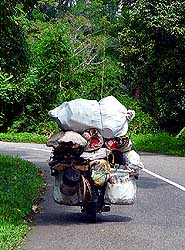
|
-
-
-
-
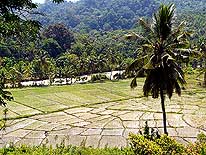
|
- 85
Dreamy landscape: A lonely
- mosque perched between rice field
- and the rainforest near Kotanopan
|
- 86
Incredible how this scooter
- manages to keep his balance on the
- winding mountain road to Bukittinggi
|
- 87
Freshly planted rice fields are
- always eye catching – there is a
- lot of hard work behind it
|
-
- The next village with a hotel seems to be 24 miles further. But being already night when
all the highly loaded heavy trucks are on the road as well (they mostly drive at night),
and not trusting anymore anyone saying that the road is “good”, we do not want
to take the risk to meet more mud in the dark. Not being allowed to camp on the hotel
premises, we persistently try to get a discount, but the concierge sticks firmly to the
tariff. We hang around for about an hour until the manager appears, but fall on deaf ears
too. “OK, we take the villa”, we finally tell him quite upset, insisting however
that we definitely want to have the four welcome drinks, four dinners (even if we never
eat at night!!) and four breakfasts that are included in the price. He looks at us a bit
puzzled and is silent for a while. “OK, I offer you the villa for one million, but
without dinner and only two breakfasts”, he decides. The deal is made, but it is hard
to lose so much money for one single night, where we only use one bed and one bathroom
anyway. Well, at least we can say that in Indonesia we slept in a
“one-million-hotel”!
|
-
-
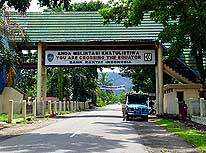
|
-
-
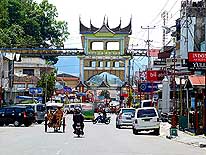
|
-
-
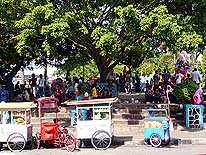
|
- 88
In Bonjol, lying in the hot plain
- between Lubuksikaping and Bukittinggi,
- we cross the Equator for the 27th time.
- Reason enough to celebrate this special
- moment with a Gin-Tonic drink
|
- 89
Bukittinggi, 3’050ft. above sea
- level, has many buildings with the
- distinctive architecture of the Minang-
- kabau highland people. Already the
- city gate has the upswept gables,
- inspired by the form of buffalo horns
|
- 90
The main square in Bukittinggi
- teems with life on Ascension Day
|
-
- A sunny morning is greeting us when we get up. By daylight, we take a closer look at the
already fading beauty of this hill resort. Tennis courts, a tiny wooden mosque, two ponds
with flowering white water lilies, each one with an adjoining decaying pavilion, are part
of the place. The rooms are in Batak-style architecture with traditional thatched roofs.
There are walkways; one leads to the Antenna. At breakfast, we are served jus, pineapple
slices, omelet and Indonesian style coffee, i.e. freshly grounded and mixed with sugar
which needs to settle before it is ready to drink. There is no bread. Luckily, we stocked
up sufficiently at Annette’s German Bakery in TukTuk before we left. Well, for one
million you cannot expect everything, can you? At 9.30am we are back on the road, and one
hour later, at the village of Padangsidempuan, we rejoin the Trans
Sumatra-“Highway”. Shortly afterwards, the road becomes single-lane. A
construction site, we guess. No, to my big joy there is a wedding taking place and of
course I ask Emil to stop. Contrary to the two previous Christian Batak weddings further North, this one is of Moslem religion. The bridal couple is
sitting on the richly decorated throne and relatives and friends have just finished
submitting their good wishes. May I possibly take a picture of them? Nobody objects.
|
-
-
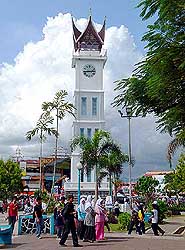
|
-
-
-
-
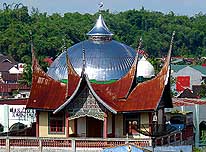
|
-
-
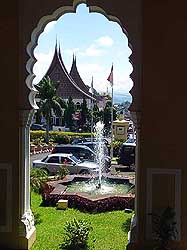
|
- 91
Jam Gadang, the Clock Tower, is
- Bukittinggi’s landmark. It was built 1926
- – a gift from the Dutch Queen. After
- Indonesia’s independence, the roof has
- been adapted to the Minangkabau culture
|
- 92
Where ever we look, the
- distinctive Minangkabau roofs
- are never far away in Bukittinggi
|
- 93
Two distinctive architectures:
- The Moorish arcade of the
- Hills Hotel in Bukittinggi and the
- gabled Minangkabau roofs
|
-
- Suddenly a young girl is on my side, embracing me spontaneously. “Are you
alone” she asks. When I explain that I am visiting with my husband who is waiting in
the car, she insists she wants to meet him. She and a crowd of youngsters follow me back
to the LandCruiser. There, we take a remembrance photo, say good-bye and, enriched by
another great experience, we drive on. The day is sunny, the road condition surprisingly
good in most parts and the landscape beautiful with its lush rice fields, palm groves and
mountain views in the back. One village follows the other and all are built along the
noisy highway. Early afternoon we reach Panyabungan and spot two hotels that make a good
impression. But it is still too early to call it a day. Therefore, we decide to continue
to the next village of Kotanopan, showing the same size on our map. Far wrong! There is
only one sleazy hostel, and it is directly along the busy and noisy road. The next village
is too far away to be reached during daytime. As unsatisfactory as it is, we have no
choice and stay. The nicest of this otherwise unattractive place is the nearby rushing
river. And surprisingly, we find a little spot where we can sit on our camping chairs
under a tree with wide branches, enjoying the shade and without curious faces around us.
|
-
-
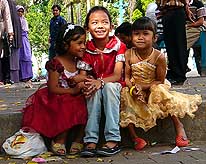
|
-
-
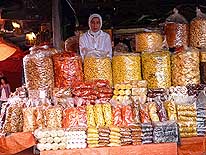
|
-
-
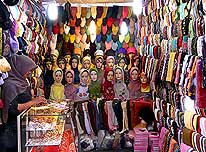
|
- 94
Three girlfriends smile somehow
- shyly when we take a picture
|
- 95
Dried food is plentiful at Pasar Atas,
- the big market in Bukittinggi …..
|
- 96
.... and the tiny market stalls are
- crammed with Islamic headscarves
|
-
- We admire the bunched green “grapes” growing directly off the trunk. On the
other side, two youngsters are taking advantage of the strong current and are speeding
downriver with inflated truck tubes. Obviously, they are having fun. When the birds are
settling on the trees with their unmistakable chirping, it is time to return to our
hostel. Since a very long time, we carry our own bedding into the room. Who knows when it
was changed the last time? It does look very filthy anyway. Being a bit airier, we sit on
the common veranda and watch the never ending traffic. But the noise is so tremendous,
that I often have to press my fingers into both ears not to go bananas. The worst are the
three wheelers with side car and the scooters without any exhaust. At some point, we
return to our sticky room with no fan and doze in and out of sleep until the morning
dawns. What a difference to our yesterdays “one million rupee-villa!” Well, here
we paid only Rp. 80’000 (US$ 9) but found out that we still overpaid it when a local
put a fifty thousand rupee bill (US$ 6) over the counter.
|
-
-
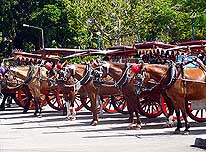
|
-
-
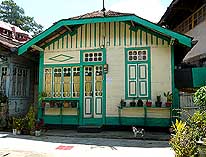
|
-
-
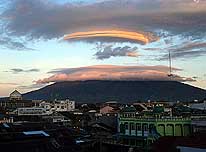
|
- 97
Nostalgic horse drawn carriages
- are waiting for customers at
- Bukittinggi’s main square
|
- 98
A cute looking house in a
- narrow side road of Bukittinggi
|
- 99
View from the balcony of our
- Hotel Benteng in Bukittinggi during an
- interesting evening ambiance, with the
- distinctive mosque in the for- and the 9’484ft.
- high Merpati volcano in the background
|
-
- At 6.30am we are up and shortly before 8am we are on our way to the last stretch to
Bukittinggi. There are still 95 miles to go for which normally seven to eight hours are
needed. Also today, rice fields are the main attraction. The road condition is acceptable,
the course very windy. Right before the village of Rao we reach the boundary of West
Sumatra, and in Bonjol, in the hot plain, we cross the Equator – for the 27th time
– reason enough to toast with a gin tonic drink and to retrace: Emil, the born
statistician, can easily name each one by heart: 3 times in Indonesia, 3 times in Ecuador, once in Brazil, 3 times in Gabon, 7 times in Uganda
and 4 times in Kenya. The remaining 6 happened for the
LandCruiser on a ship, while we sat 4 times in a plane and attended only twice a
line-crossing ceremony. In West Sumatra, everything seems to be tidier. The houses look
neater, there is less garbage lying around. Around 3pm, we are driving into Bukittinggi,
the heart of the Minangkabau culture. Situated at an altitude of 3.050ft., we are able to
breathe fresh air again. Following his intuition, Emil takes the Panorama Road which leads
to the highest point of the city, where on the top we discover the Benteng Hotel that not
only offers safe parking, but also a bright, airy room with balcony, overlooking the city
and the 9’484ft high Merpati volcano, which is greeting us shrouded in clouds. There
is also WiFi connection, but only in the lobby. The price of Rp. 225’000, US$25,
including breakfast, is OK for us.
|
-
-
-
-
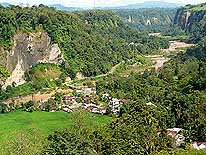
|
-
-
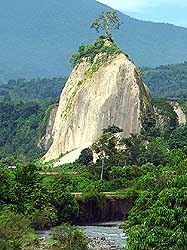
|
-
-
-
-
-
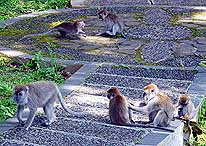
|
- 100
From the Panorama Park in
- the West of Bukittinggi we enjoy
- the view to the Sianok Canyon .....
|
- 101
..... with its bizarre
- rock formations .....
|
- 102
..... and the peaceful monkey
- families that are living there
|
-
- “Allahu Akbar” it suddenly blares ear deafening from the loudspeaker of the
opposite green mosque, which dominates the cityscape. Little did we know that there is
more to it than the five times call of the muezzin for prayer, that the entire religious
sermon (or whatever it might be) will be broadcasted in the same incredible loudness
– and this several times a day. There are not many moments where it remains silent.
Regularly, at 4am, our deep sleep is abruptly interrupted. Escaping isn’t possible,
no matter where the lodge might be situated in the city. Simply incredible! There is no
doubt: We are in a more fundamentalist place. In the many years of traveling, we visited
many Islamic states, but nowhere else we experienced something like that. On the other
hand, when we sit on our balcony watching the skies turning red over Gunung Merapi and the
muezzin’s call echoes from near and far, it is such a tremendous, intense and exotic
feeling that we will never forget.
|
-
-
-
-
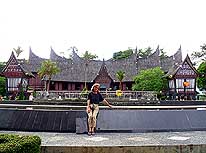
|
-
-
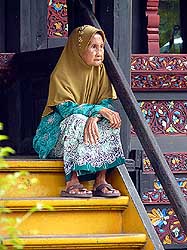
|
-
-
-
-
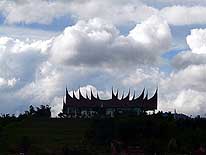
|
- 103
Liliana is sitting in front of the city
- museum that was built in the Minangkabau
- style in 1934. Left and right are rice barns …..
|
- 104
….. an elderly lady is
- sitting on the steps leading into
- the interior of the museum
|
- 105
Minangkabau roofs
- tower towards stormy skies
|
-
- Despite the interrupted sleep, we keep staying at the Benteng Hotel. Here we are allowed
to park our LandCruiser in safety when on May 6th, we fly from Padang, 55 miles further
South, to Kuala Lumpur for a visa run and a dentist visit. Who would have imagined that in
Malaysia’s capital we will enjoy an evening with same-minded car travelers: With the
Swiss Karin and Jan, Carmen and Martin, and the Germans Silvie and Wim. With all parties,
we had already contact by email before. Getting to know them now personally, is really
nice. We all share the same taste of adventure and the same desire to walk away from the
conventional lifestyle. Beer is flowing in abundance in Chinatown while swapping stories
– and it just happens to be also our 41st wedding anniversary! Five days later, we
are back in Sumatra with a new two months Indonesian visa. We are happy to find our
precious LandCruiser untouched at the parking of the Benteng Hotel, when we descend from
the minibus, which took us for Rp. 35’000 each (= US$ 4) – in a two hours ride
from the airport of Padang up to Bukittinggi.
|
-
-
-
-
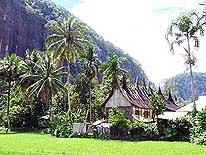
|
-
-
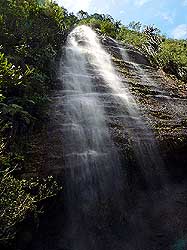
|
-
-
-
-
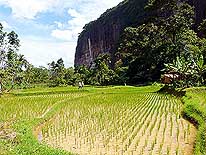
|
- 106
A vertical cliff, a lush rice field, majestic
- palm trees and a traditional Minangkabau
- house – one of the most beautiful spots in
- Harau Canyon, 35 miles East of Bukittinggi
|
- 107
A waterfall drops over
- a vertical, 330ft. high cliff of
- the Harau Canyon down
- to the valley
|
- 108
Two guys walk across a rice
- field to the “Lembah Harau Echo
- Homestay” that is situated
- right under a cliff
|
-
- The hotel itself is a good choice: Separated by a few steps only is the city center with
its busy life, with the nostalgic horse drawn carriages on the streets, the exotic market
crammed with all kind of different goods, and the clock tower – Bukittinggi’s
landmark. Even the impressive Sianok Canyon at the Southern end is not far away, where at
its panorama park peaceful monkeys keep us company. There is also no lack of cozy cafes
that spoil us for little money with traditional, but also Western food. We change between
the Canyon, the Bedudal, the Apache and the Turret restaurants. In the average we pay
between 8 and 11 US Dollars for two meals, including two big bottles of local Bintang
beer. One bottle costs between Rp. 24’000 and Rp. 30’000 (= US$ 2.60-3.30) what
is actually more expensive than a complete menu. Occasionally, after ordering, a guy jumps
on his scooter and speeds away to buy some groceries. He returns with a bag of potatoes,
or a pineapple, or some vegetables – things that he needs to prepare our meals.
Therefore it can easily happen that we have to wait for almost one hour. Well, aren’t
we on holiday?
|
-
-
-
-
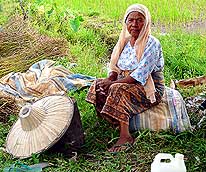
|
-
-
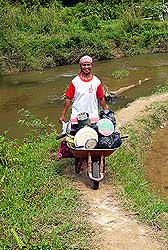
|
-
-
-
-

|
- 109
A paddy farmer lady makes
- a well deserved break .....
|
- 110
..... another peasant woman
- pushes her barrow to the paddy field .....
|
- 111
..... another woman sells
- “energy cracker” in front of her house
|
-
- The Minangkabau highland people are strongly devoted Muslims and well known for their
high intellect. They form one of the few still existing matrilineal societies on earth
where property and land is passing down the female line, i.e. from mother to daughter.
Their traditional houses are built from wood and roofs have several turned up gables,
inspired by the horns of buffaloes that play a major role in their culture. We admire them
at homes, mosques, yes even at gasoline stations. The most intriguing sight however is the
incredibly beautiful wood carving that adorns entire houses in finest details.
Bukittinggi’s museum, built in Minangkabau style in 1934, gives us a good example of
this cultural treasure, which we are able to explore next day in the Minang Highlands. The
roads are undulating peacefully, up and down the hills, past the omnipresent lush carpets
of paddy fields. They are in surprisingly good condition – up to now the best ones we
encountered in Sumatra. Everywhere rice, nuts and cloves is laid out on mats to dry in the
sun; the aromatic scent of cloves saturates the air. Some rice fields are in full harvest,
others are about to be ploughed the ancient way with water buffaloes. Now and then, we
encounter a woman walking home with a basket or a bucket on her head, reviving memories of
Africa.
|
-
-
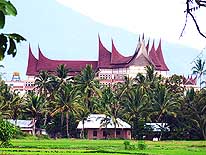
|
-
-
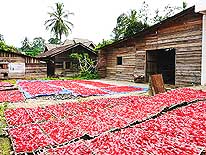
|
-
-
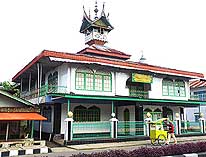
|
- 112
Between the village of Harau
- and the city of Payakumbuh, this building
- like a palace attracts our attention
- between palm trees and paddy fields
|
- 113
East of Bukittinggi Cassava
- is growing and is laid out to
- dry along the road
|
- 114
Also this mosque in
- Payakumbuh has a touch of
- the Minangkabau architecture,
- at least with its “dome”
|
-
- It is not always easy to find the villages mentioned in the Lonely Planet guidebook.
With missing road signs, it can happen that we take a wrong turn, but at the end, we
always are standing full of admiration in front of these unique cultural buildings. In
Silinduang Bulan there is unfortunately not much left to admire from the Royal
Palaces – only the new Kings Palace that is still under construction. It replaces the
original one caught by lightening in February 27th, 2007. Incredibly, on March 21st, 2010,
also the Palace of the Queen burnt down; only the ruins remain, but the two surviving rice
barns are still silent witnesses of its former glory. We find a handful of other small
jewels - the most attractive ones – in different villages hidden between conventional
houses. Even Emil, who is not as easily overwhelmed as myself and who does not overrate
everything like I do (according to Emil!) is busy taking pictures! It is finally also him,
who still insists to visit also the village of Belimbing, situated halfway between
Batusangkar and Lake Singkarak. According to Lonely Planet, this place offers the biggest
concentration of over 300 years old houses, though regrettably in different stages of
decay. If we thought to find them as richly decorated as before, we are completely
disillusioned. What remains are modest, undecorated wooden structures, which however
convey a kind of tranquility in their simplicity and rural environment, together with
grazing cows and calves.
|
-
-
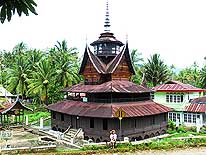
|
-
-
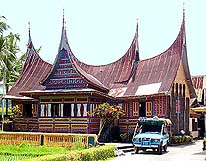
|
-
-
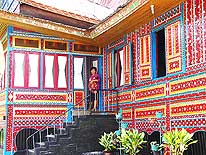
|
- 115
The traditional “Surau Nagari” –
- an Islamic men’s house – is built entirely
- of wood and sits in the village of Batipuh,
- South of Bukittinggi, near Padangpanjang
|
- 116
A beautifully decorated traditional
- Minangkabau home in Batusangkar, the
- capital of the ancient kingdom of Minang-
- kabau in the Tanah Datar region …..
|
- 117
….. Close-up view –
- a real splendor!
|
-
- It is the most beautiful and clearest day since we made Bukittinggi our base to explore
the region of the Minangkabau people, when we take the 24 miles of road to Danau Maninjau,
a perfectly formed crater lake. On our map we find a viewpoint not mentioned in any travel
guide book. It is called “Puncak Lawang” and is situated 4 miles north of the
village of Matur. This is the place we are heading to, but at some point we have to ask
for directions again. Being apparently a well known paragliding hill, for once we get
directed straightaway to the right road, what is not always the case. It is after 10am,
when we park our LandCuiser at 3’280 ft. altitude at the tiny forest parking and walk
the couple of steps to the viewpoint. What an exciting sight: The surface of the water is
calm as a mirror reflecting the crater rim and white clouds in bizarre formations. We sit
down on the grass and absorb the serenity and beauty of this wonderful lake. A feeling of
complete peace takes over. To make the moment even more special, yellow dragonflies
perform a dance right above our heads. Can life be more beautiful?
|
-
-
-
-
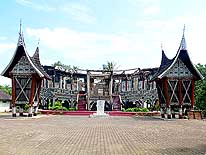
|
-
-
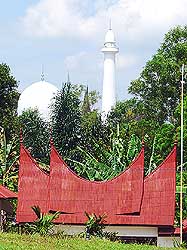
|
-
-
-
-
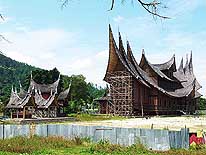
|
- 118
The ruins of the „Queens Palace“
- (Pagaruyung) in Silinduang Bulan near
- Batusangkar that was demolished by a
- fire on 3/21/2010. The two beautiful rice
- barns survived. The “Kings Palace” (Basa
- Pagaruyung), which lies just a few hundred
- yards away, burnt down on 2/27/2007
- by lightning and is currently rebuilt
|
- 119
Traditional and modern
- architecture in Silinduang
- Bulan near Batusangkar
|
- 120
The new monumental
- “Kings Palace” in Silinduang Bulan
- near Batusangkar is still under
- construction after the old one was
- hit by lightening on 2/27/2007
- and burnt to the ground
|
-
- 44 switchbacks, monitored by curious monkeys alongside, lead us down to the lake at
1’500 ft. above sea level and to the charming village of Maninjau, where fish farming
is conducted. At the beginning of 2007, 7’000 metric tons of fish died. Some blame
escaping sulfide gas from hot underwater springs, some attribute it to the overproduction
of the 15’000 fish farms around the 38 sq.mi. sized lake. The road circling the lake
is a narrow single-lane track and crossing another vehicle is always a delicate matter.
Emil knows how wide our car is, but does the other driver know this from his vehicle too?
The heat is increasing steadily and we are ready for our picnic, but find not one trace
leading to the lake shore, at least not with a car. Footpaths through rice fields that
cover big areas are plentiful though. Like the village of TukTuk at Lake Toba, it is
evident also here that the tourist business is lying idle. Apart from two backpackers
walking through a field towards a homestead, there is no sign of tourism.
|
-
-
-
-

|
-
-
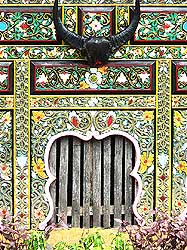
|
-
-
-
-
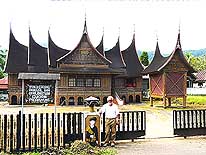
|
- 121
In small villages, we discover
- now and then further jewels of the
- Minangkabau culture …..
|
- 122
..... lovely detail of
- the traditional home
|
- 123
Emil poses for a picture in front
- of another traditional Minangkabau
- house, again near Batusangkar
|
-
- We start our way back already in the afternoon as we didn’t find any suitable
picnic spot. This means taking the same 44 sharp hairpins uphill, what doesn’t go so
smoothly. Short before a hairpin turn, our LandCruiser begins to stutter, and then the
engine dies – of course at the most inconvenient place. Already some time ago we
noticed that the fuel pumps flown in from the United States
to American Samoa and installed there – actually they
are meant for aircrafts – now and then are working like mad. Are they too weak? Not
in the best mood, Emil lies underneath the car to check the fuel lines and electrical
cables. “The filter is empty, no fuel is running”, he shouts. After all the air
from the fuel lines was bled and the carburetor cooled down the engine runs again, but
only for a few more bends. Then we go through the same painful procedure once more.
Therefore we are more than happy when we finally manage to reach the top. We find easily a
good spot opposite the Hotel Nuansa, where we finally can enjoy our late picnic.
|
-
-
-
-
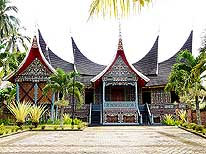
|
-
-
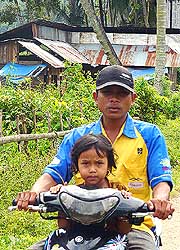
|
-
-
-
-
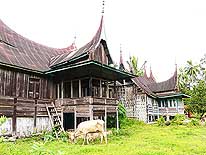
|
- 124
Another example of a
- Minangkabau house in Batusangkar
- with its elaborately carved exterior
|
- 125
Who is taking whom for a ride?
|
- 126
The village of Belimbing, which
- lies about halfway between Batu-
- sangkar and Lake Singkarak, has the
- biggest concentration of Minangkabau
- buildings that survived “more or less”
|
-
- After all the excitement, the cold beer from our car refrigerator flows like champagne
down our dry throats, and the chicken sausage and bread, coated with spicy mayonnaise,
helps to make us feel better. A black dog with a blind eye sits patiently in front of our
open door, watching each bite. Who would have the heart not to share a bit? A tropical
downpour finally chases it away, and for us it is a welcome drop of temperature. On our
way back to Bukittinggi, the second mishap of the day occurs: When giving way to an
oncoming car, we end up in the too soft shoulder and are hopelessly stuck! Despite of
engaging our 4x4, nothing moves. In no time a crowd of people surrounds us, mopeds stop
– exactly like in India! But our entertainment is of a short nature. We grab our
shovel – no one of us remembers when we last used it, but it seems eternities away
– and we easily manage to free us ourselves. Then we just are longing for one thing:
A refreshing shower.
|
-
-
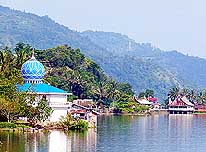
|
-
-
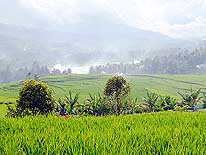
|
-
-
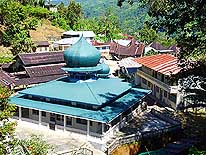
|
- 127
Lake shore at peaceful Danau
- (= lake) Singkarak in Ombilin,
- where we make our lunch break
|
- 128
The smoke of the harvested paddy
- field fires rise everywhere towards
- the sky and leaves everything in haze
|
- 129
Mountain village of Sungai Landia
- between Bukittinggi and Manijau, where –
- like everywhere – the mosque dominates
|
-
- Next day, we head with great expectations to the Harau Canyon – 35 miles East of
Bukittinggi. We are eager to escape the eternal noise of the city for a while and to be
surrounded by nature’s beauty. Already at the canyon’s entry, we are in awe: A
reddish cliff as high as 330ft rises into the blue sky with gentle waterfalls cascading
down to the fertile valley covered with paddy fields and majestic coconut trees. The
deeper we drive into the canyon, the more impressive it gets. In the morning we checked
out at our city hotel and are now planning to book into the canyon’s “Lembah
Harau Echo Homestay” for a couple of days. It is sitting on a hill behind a
peacefully running river and hidden by trees. And the bungalows are right at the foot of
the vertical wall. They fit so perfectly into the surrounding that we promptly miss them
first and drive past, their access being by a small foot bridge only. Yes, and it is
exactly this bridge that is messing up all our beautiful plans. Where are we parking our
LandCruiser? To leave it for several nights at the unguarded small river parking along the
road is far too risky. And there is no other possibility. It is such a shame as we were so
longing for it. However when we later discover that a student’s seminar is just
taking place at the hotel, we take it as a small consolation that we end up with a day
trip only. It might not have been as quiet as we hoped for. Disappointed, we return to our
noisy city hotel opposite of the mosque.
|
-
-
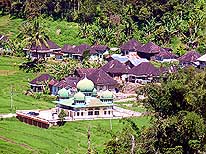
|
-
-
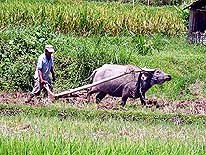
|
-
-
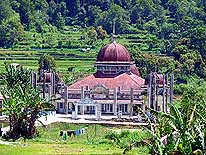
|
- 130
Peaceful image of the village
- Sungai Landia, surrounded by rice
- fields and forest. It’s along the road
- from Bukittinggi to Lake Maninjau
|
- 131
Hard work for farmer and
- water buffalo: Plowing a rice paddy
|
- 132
Also in the countryside,
- mosques are monumental: On the
- way from Matur to Danau Maninjau
- (= Lake Maninjau)
|
-
- One day, eating at the Canyon Cafe chicken steak and vegetable taco for lunch, we watch
a marquee being erected just opposite. We learn that a traditional Minangkabau wedding is
taking place tomorrow. Being right down the road from our hotel, I try to get a glance of
the festivities next day. While taking a picture of the lovely tent, a gentleman
introduces himself as the brother of the groom (or is it the bride?) and welcomes me
inside. A bit shy, I follow him. He directs me to a splendidly decorated room where
different dishes cover the middle part of the floor. At the head of it, right underneath
the throne, sits the groom, joined by male family members on both sides. They are praying
and then start eating. It seems to be a merely men’s ceremony. When might the bride
appear? “In about an hour” says the girl, who is keeping me company. She
introduces me to her mother, sisters, uncles and cousins. When I return one hour later,
the newlyweds are already sitting on the golden throne. I can hardly take my eyes off
them.
|
-
-
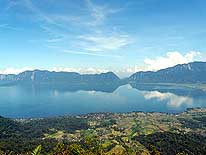
|
-
-
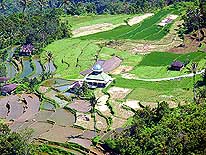
|
-
-
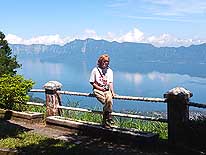
|
- 133
From the viewpoint “Puncak
- Lawang“, 4 miles North of the village of
- Matur, we absorb the serenity and beauty
- of the beautiful crater lake Maninjau.
- The hill is also known for paragliding
|
- 134
From the viewpoint „Puncak
- Lawang“we spot on the
- Northeastern slope of Danau
- Maninjau this idyllic
- mosque between paddies
|
- 135
Liliana is enjoying the tranquility
- that surrounds Danau Maninjau –
- for once no speeding and
- ear-deafening scooters
|
-
- The bride wears a golden crown and looks really like a queen, reviving memories of the 1001-Night-Wedding of a princess in Dubai in the United Arab Emirates. They are just receiving the first group
of well-wishers with the usual photo session. I am encouraged to do so too, after I have
been introduced to them. Later, it is impossible to refuse the invitation to eat, and I am
also touched when I even receive a gift: A blue face towel neatly folded and nicely
wrapped in a transparent little box. When the music starts in the Indonesian ear-deafening
way – it will last until midnight – I leave full of joy for the great
friendliness extended to me. Emil, who never feels comfortable with too much attention,
stayed behind at the hotel. Being back, we discuss how contradictory things are in this
country: On one side, a couple of days ago, a terrorist plot was uncovered in Jakarta
where on Independence Day in August not only the President should be killed, but also as
many “infidel” whites as possible. On the other hand, I have been invited by the
same people so generously to a wedding just because I am a “Westerner”.
|
-
-
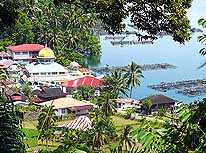
|
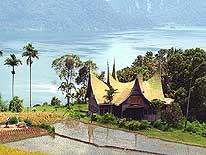
|
-
-
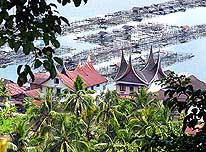
|
- 136
Maninjau is situated picturesquely
- at Lake Maninjau’s Eastern shore
|
- 137
Gives us a kind of a Far East
- sensation: View from one of the 44
- switchbacks leading to Danau Maninjau
|
- 138
Fish farming at Lake Maninjau.
- Beginning of 2007, 7’000 tons of fish
- died; some believe due to escaping
- sulphur from hot underwater springs,
- others due to an overproduction from
- the 15’000 fish farms around the
- 38 sq.mi. 'big' lake
|
-
- The days in Bukittinggi spin away. Soon there is only one month left before our second
visa expires and we still do not know what next, whether our planned land border crossing
from Indonesian Papua to Papua New Guinea will be approved
or not. Day by day we are waiting for the crucial answer, and day by day we are
disappointed. It is therefore very important for us to follow it constantly and be
connected to the internet. Why then not stay in this comfortable mountain climate with all
the hotel amenities until we get green light? And since we discovered that on the same
street there is a little place selling wonderful cakes, among others black forest and
Sacher, our decision is made: We are waiting here. We are told that the development of our
application is typical of PNG: Since we started with our inquiry last December at the PNG
Ministry of Tourism, we received 15 emails from its CEO, 8 of them with the assurance that
all the original permits are in his hands and that he will send us the respective copies.
But day after day and week after week passed and we are still empty-handed.
|
-
-
-
-
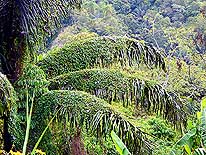
|
-
-
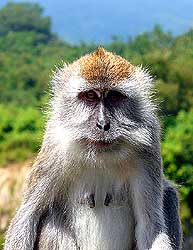
|
-
-
-
-
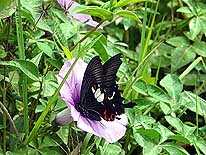
|
- 139
Twiners are covering entire
- palm leaves in the tropical forest in
- the Sianok Canyon near Bukittinggi
|
- 140
A curious monkey, which
- is often seen sitting alongside
- a road: Macaques
|
- 141
Nature at its loveliest
|
-
- What are we going to do? But when CEO Peter Vincent mentions in one of his emails that
he even might fly to the Jayapura/Vanimo border to assist us with customs formalities, we
trust his reiterated assurances and start happily with our shipping investigations from
North Sulawesi to West Papua. Unfortunately it shows that this freight would exceed by far
our budget. We find only two vessels running this route regularly: The government owned
Pelni charging US$2’700, and a freighter for only US$600 less. Both accept only
containers. In addition, we would have to count with US$900 from West Papua either to
Madang or Lae in Papua New Guinea. Therefore, there is only
one solution for us: To change our route and ship from Jakarta directly to Lae. We inform
the PNG’s Ministry of Tourism accordingly, which appreciates this easier port of
entry. Hence we book our container for July 7th, and our flights to Port Moresby via Malaysia and Singapore for July
8th, – a bit overhasty, as it shows in retrospect. Because despite of all the
assurances, the situation still remains unclear on June 1st, 2010.
|
-
-
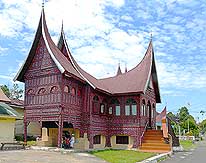
|
-
-
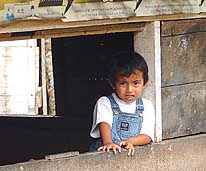
|
-
-
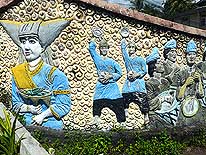
|
- 142
This beautiful adorned Minangkabau
- house is situated in Koto Gadang, a silver-
- smith village 6 miles outside of Bukittinggi
|
- 143
“Hello! – Hello Mister!”
- sounds persistently from a window
|
- 144
Mural along the Eastern shore
- of lake Maninjau depicting the
- culture of the Minangkabau people
|
-
- Slowly we start giving it a second speculation: Are the permits eventually not issued at
all, or are we finally expected to bribe. Or even worse: Is this the end of our PNG-dream?
All kind of worrying thoughts run through our heads. But we are not yet giving up! Acting
according to the saying “You don’t quit trying when you lose, you lose because
you quit trying!” we write email after email, grasp each possibility and each straw.
Then, finally a flicker of hope pops up: “We are happy to help you”, the agency
of the Swire shipping line based in PNG’s capital Port Moresby writes us. The
following week, we anxiously check every day our emails for a positive answer. On June
11th, there is an answer, but not what we hoped to hear, and our moral drops almost to
zero. Strangely, the agency could not make any contact with the CEO of the Ministry of
Tourism. But what put us most over the edge are their words: “The difficulties are
blown out of proportion”. What now? At least, they promise to continue to find a
solution. This is the current situation on June 12th, exactly 25 days before we plan to
containerize our LandCruiser. But mankind is living of hope! Therefore, despite of the
incertitude of our next destination, we close our camp in Bukittinggi – the heart of
the Minangkabau culture – and start heading towards Southern
Sumatra and on to Java and Jakarta.
|
-
-
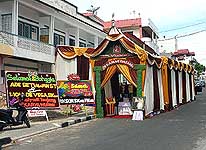
|
-
-
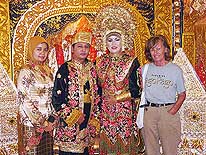
|
-
-
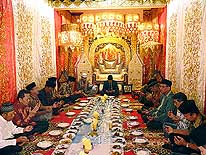
|
- 145
A marquee has been erected
- alongside the street next to the „Orchid“
- Hotel in Bukittinggi, where a traditional
- Minangkabau wedding is taking place …..
|
- 146
..... where Liliana is introduced
- to the bridal couple in their traditional
- “royal” outfit and may
- join for a picture …..
|
- 147
..... and where beforehand a
- traditional men’s gathering took
- place. At the top is sitting the groom,
- his relatives joined on both sides
|
-
|
|
To the previous website: Pictures from our
2010-Indonesian trip in North Sumatra in April and March
2010 |
|
To the continuation: Pictures from our
2010-Indonesian trip in Southern Sumatra in June 2010 |
|
|
- More websites from Indonesia and
Timor-Leste:
More websites from East Malaysia and
Brunei:
|
![]()
